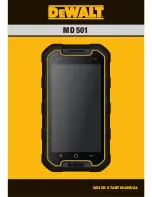
Digital Monitoring Products
iComSL
Series Universal Communicator Installation and Programming Guide
28
Appendix
test zone trips occur, the test ends and a final Sensor Reset automatically occurs. The
System Test End message is sent to the receiver along with Verify and Fail messages for
each zone under WALK test. Faulted zones then display on the keypad.
Failed Zones Display
Each zone that did not trip at least once during the Walk Test displays on the keypad
that initiated the test. Any Panic (PN) or Supervisory (SV) 24-hour zone that is faulted
at the end of the Walk Test displays a trouble condition for that zone regardless of the
message programmed for the open or short condition of the zone and a zone trouble is
sent to the receiver. Press the COMMAND key to display the next failed zone.
18.5 Cross Zoning
Caution must be taken when cross zoning devices to ensure that the Cross Zone Time is long enough to allow a
trip of both zones before it expires. A Cross Zone Time that is too short may allow a trip of the zones and only a
zone fault report be sent to the Central Station.
When a Cross Zoned zone trips, a FAULT report is sent to the SCS-1R or SCS-VR Receivers. When two Cross Zoned
zones trip within the Cross Zone Time, both zones send ALARM signals to the receiver. For example, if zones 1
and 2 are Cross Zoned zones, and only zone 1 trips, a FAULT report is sent to the receiver for zone 1. If zone 1
trips and zone 2 trips within the Cross Zone Time, an ALARM report is sent to the receiver for zone 1 and zone 2.
Note: To operate correctly, all cross-zone zones need to be programmed as the same zone type.
18.6 Z-Wave Information
The iComSLCZ is a security enabled Z-Wave product and is designed to be used as a primary controller.
The XFER feature allows an existing 3rd party network to be transferred into the iComSLCZ.
The iComSLCZ can support Z-Wave products from different vendors and product categories. It is recommended to
use devices listed on the buy.dmp.com site for best performance.
Z-Wave terminology:
• Inclusion is the process of adding a device to the Z-Wave network. The new device is ‘included’ into the
Z-Wave network.
• Exclusion is the process of removing a device from the Z-Wave network. The new device is ‘excluded’ from
the Z-Wave network.
• Replication is the process of copying network information to another device (typically a Z-Wave controller) in
the Z-Wave network.
18.7 Zone 4 Bell Cadence Information
The iComSL evaluates the first 3.5 seconds of bell cadence timing to detect the type of alarm sent.
Bell cadence types are:
BELL CADENCE
ZONE NUMBER
TYPE OF MESSAGE
Steady
ZONE 4
BURGLARY
Pulse or Temporal 3
ZONE 5
FIRE
Temporal 4
ZONE 6
EMERGENCY OR
CARBON MONOXIDE
Figure 16: Zone 4 Bell Cadence Information
SOUTH LOBBY
ZONE: 10
-FAIL
Steady
Pulse
Temporal 3
Temporal 4
1.0 sec.
1.0 sec.
1.0 sec.
1.0 sec.
1.0 sec.
.5 sec.
.5 sec.
.5 sec.
1.5 sec.
.5 sec.
.5 sec.
.5 sec.
.5 sec.
3.5 sec.
Each .1 sec. On
5.0 sec.
On
Off
On
Off
On
Off
On
Off
Each .1 sec. Off
Each .1 sec. On
Each .1 sec. Off





































